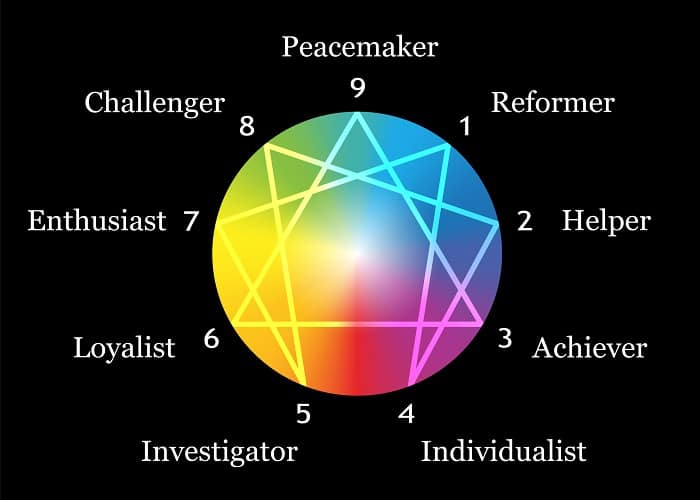
A while ago I wanted to know what it means to be ‘healthier.’ I’m fairly in-shape, I like to walk when I can and my love for cooking has helped me to better my diet over the years.
While all of these are purely physical manifestations of health, surely health extends beyond the physical? That led me to wonder what was missing in aspects of my health that weren’t physical. To gain inspiration I asked some friends what they thought on the topic and was pleased to then be speaking to some of their friends.
They too had undergone difficult times and grown from them. The first recommendation from John led me to something called the Enneagram.
The Enneagram test is a personality model. He described it as a model for figuring out who you are. Each person will belong to one of 9 personality types, hence the name ‘ennea,’ meaning 9 in Greek.
In the simplest description, each type has natural strengths and weaknesses, along with typical fears and desires. With this knowledge, a person who is conscious of their type will be able to boost their strengths and limit the impact of their weaknesses.
This may be applied anywhere in their life, from professional to personal, romantic to platonic. The first step to unlocking this potential comes from a person being conscious of their type.
The Achiever: Sometimes you need a rest day
John already knew his enneagram type, having been introduced to the concept by a psychology student in college. He knew that as a Type 3, an Achiever, his weaknesses were that he could be too image conscious, competitive to a fault, had difficulty in accepting failure, but most importantly, he could easily neglect personal needs for the sake of a goal.
John was a few years out of college. He had moved out of his parents’ home and was living in a new city; he had moved there to be closer to his new job. In the past year he had made a group of friends and they all had in common that they were new to the city too.
John wanted to make the most of the time he had there and was always happy to accept social invites, partying at least twice a week. He combined this with trying new activities out in a bid to make friends and establish himself in the city. Monday night could be badminton. Thursdays were the live music night in the city.
One evening he returned from work totally burned out, and it was only a Tuesday evening – the week had only just begun. John knew that something wasn’t right, so he consulted the Enneagram.
He noted that a classic weakness of a Type 3 is that they neglect their personal needs over their striving for achievement and purpose. John had put so much energy into his new job and his new life in the city, that he had not taken the time to care for himself.
Right away he cancelled the plans he had made later that week. Instead, he came home straight after work, cooked himself dinner and had a quiet evening. The weekend he had managed to keep to himself.
By Sunday night he was feeling recharged. He didn’t feel guilty about turning down social commitments. John told me how he felt refreshed for the first time in a while. And he returned to his work with renewed vigor.
He said he felt much lighter and prouder of what he had achieved. It had only taken a weekend to see this. The Enneagram had helped him reflect on his character and gave him guidance on how to develop his type’s natural unhealthy behavior into something much healthier.
Of course, this health improvement strategy for John would not work on people who are not Type 3s – not all types are the same. Enneagram types are intrinsically linked with one another. When a person is really on a high, they will possess the strengths from a different type.
This effect is amplified by their existing strengths or weaknesses still being present too. There is a symmetry in this model. Under periods of intense stress each enneagram type will begin to exhibit unhealthy levels of the weaknesses of another type. These are known as Arrows. More information on Type 3 arrows can be found on this Enneagram Type 3 page.
The Peacemaker: Finding your voice
John told me of his wife’s friend Mary. Mary works at a small crafts shop, the kind which hosts children’s birthday parties on weekends and where couples paint pottery and enjoy a cup of coffee on a cold winter’s day together.
The studio has run for many years, and she’s found herself at home there. It fits her amiable, creative personality, interacting with different faces in a familiar place many days of the week. She’s naturally gifted at resolving arguments at home. She always presents a solution to her partner with a heartfelt expression of sympathy.
At work, in quite a contrast to this, she avoids conflict whenever possible. In other words, Mary is an Enneagram Type 9.
John and Mary began chatting one evening and Mary expressed her interest in creativity and spirituality and her strong belief that it’s absolutely tied in with self-improving. This is when he introduced her to the Enneagram from his hunch.
“You can take it or leave it and use it however you wish,” John told Mary. Mary took the test, was identified as a Type 9, a Peacemaker, and found so much of it rang true with her, the strengths and weaknesses she possessed.
The classic weakness of the Type 9 is avoiding confrontation at all costs, even to the detriment of her own life personally, especially over the long term. She set it her goal to resolve this difficulty.
The owner of the pottery workshop, Gemma, had always doubted Mary’s ability to handle delicate situations with customers when they fell upon her. Gemma had even gone as far to say that Mary should stop dealing with irate customers altogether.
But Mary knew she had to challenge these weaknesses and she saw an opportunity here to assist in one small way at work. She would take the initiative to squeeze in when she noticed a situation turning sour between an upset customer and Gemma.
Difficult at first, Mary grew to recognize quite how good she was at this, and soon enough Gemma was full of praise for Mary’s talent in conflict resolution. As the smile grew on her face each time she helped resolve a conflict, her confidence in herself to do the same in other situations, also grew.
So far, these definitions of healthy are far from the traditional physical sense of the word, but John and Mary have bettered themselves by being honest with who they are, how they can grow from within, and learn from without.
Certainly for John, he felt relieved and relaxed; Mary is now conscious of an important ability she has of bridging the gap between unhappy people. They’ve both unlocked more of their potential through deep self-reflection and the Enneagram advice.
The Loyalist
Lastly, we arrive with Samantha. Samantha is an inquisitive character, and her story starts with her enjoyment of learning languages. Her passion is not just for the sounds, the stories, and the beauty of the language, but the cold, mechanical structures that make it up.
She knows that it’s only a hobby for her and has always described herself as a dabbler; she’d pick up a few phrases here or there, but struggle to dedicate hours a day for months on end to master a language.
She’d be fascinated to discover conjugation in French but would halt her progress when it came to learning a variety of nouns. And therein, lay the struggle of Samantha’s language learning journey.
Describing herself as a dabbler is a common way to describe Samantha’s behavior. The Enneagram identifies this as a frequent weakness of a Type 6, a Loyalist – a tendency to abandon rather than complete goals. It may even, paradoxically, be seen as a fear of success.
I told Samantha that I thought she was a Type 6 and to check out the Enneagram, which she did with unexpected enthusiasm. Upon reading about her type and her difficulty with goal completion, she set out with a renewed perspective.
She realized that each time she had dabbled with something new, it was her reaching out to an unknown and unplanned goal. This was herself growing through her innate curiosity and by no means was a negative trait.
Looking at this as something to minimize and not fundamentally change, Samantha devised a method, entirely tailored to her, to overcome this hurdle inherent in her personality. It started with setting smaller goals for her language ambitions, knowing that she would like to drop things when a new interest popped up.
She began by writing down her language goals, what she’d picked up and… a far longer list of what she’d dropped. And with renewed focus, starting tackling her small goals one by one.
A year later, she now feels that she’s made much progress. She’s okay just planning for a few weeks ahead rather than months, and she’s learned to give herself a break. She watched French films for 3 months. She spent 3 months on learning a number of Chinese characters.
Her goals are smaller, but she’s achieving more of them than before and feeling much better about herself. Having paid attention to her potential fear of failure, she has found a way to minimize her weaknesses, and has never felt healthier.
In Summary
Have any of these personal stories expressed here made you reflect upon yourself in some way? There’s a lot to being healthy. I hope these stories illustrate to you that there are many paths you can take on the journey to unlocking a healthier you. And there isn’t a one-size fits all solution.
You need to reflect on who you are, what might be holding you back, and what can you do specifically that can help you overcome those obstacles. Self-assessment and reflection doesn’t come easy for all of us, so the enneagram test is a great tool in helping you get your foot off the ground. The best time to start is always now.
About the author
Chloe Yarwood is a lead researcher at PersonalityData.org and part-time researcher for Test Partnership. She holds an MSc in advanced applied psychology from the University of Chichester.
Powerful. Flexible. Intuitive. Innovative. Transformative.
You may also be interested in:
1. Short & Valuable Life Lessons
2. EFT Tapping Scripts: The Pros and Cons
3. Affirmations For Self Confidence

![Profound Meditation Program [Full Spectrum]](https://meditationbrainwaves.com/wp-content/uploads/2021/08/pmp-3-image-23.08.2021.jpg)

